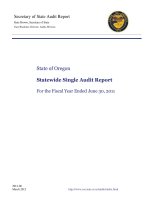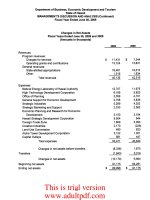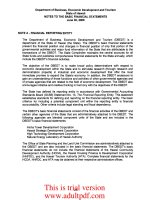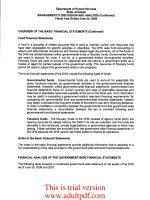FINANCIAL AUDIT OF THE DEPARTMENT OF HUMAN SERVICES STATE OF HAWAII Fiscal Year Ended June 3D, 2008_part2 doc
Bạn đang xem bản rút gọn của tài liệu. Xem và tải ngay bản đầy đủ của tài liệu tại đây (561.55 KB, 10 trang )
Department
of
Human Services
State
of
Hawaii
MANAGEMENT'S DISCUSSION AND ANALYSIS (Continued)
Fiscal Year Ended June 30, 2008
OVERVIEW OF THE BASIC FINANCIAL STATEMENTS (Continued)
Fund Financial Statements
A fund
is
a grouping of related accounts that
is
used to maintain control over resources that
have been segregated for specific activities or objectives. The
DHS
uses fund accounting to
ensure and demonstrate compliance with finance-related legal requirements. All of the funds of
the DHS are divided between either governmental funds or fiduciary funds. Governmental funds
are used to account for most, if not all, of a government entity's tax-supported activities.
Fiduciary funds are used to account for resources that are held
by
a government entity
as
a
trustee or agent for parties outside of the government entity. The resources of fiduciary funds
cannot
be
used to support the government entity's
own
programs.
The fund financial statements of the DHS include the following types of funds:
Governmental
funds
- Governmental funds are used to account for essentially the
same functions reported as governmental activities
in
the government-wide financial
statements. However, unlike government-wide financial statements, governmental fund
financial statements focus
on
current sources and uses of spendable resources and
balances of spendable resources available at the end of the fiscal year. Such information
may
be
useful
in
evaluating a government entity's near-term financing requirements.
By
comparing the governmental fund and government-wide financial statements, readers
may better understand the long-term impact of the entity's near-term financing decisions.
In
order to facilitate a comparison between the governmental fund and government-wide
financial statements, a reconciliation between the two
is
provided following each
governmental fund financial statements.
Fiduciary
funds
- The fiduciary funds of the DHS consists of agency funds which are
clearing accounts for assets held by the DHS
in
its role as custodian until the funds are
allocated to the individuals, private organizations, or government agencies to which they
belong. These activities are excluded from the government-wide financial statements of
the DHS because the DHS cannot use these assets to finance its operations.
Notes
to
the Basic Financial Statements
The notes to the basic financial statements provide additional information that
is
essential to a
full understanding of the data provided
in
the government-wide and fund financial statements.
FINANCIAL ANALYSIS
OF
THE GOVERNMENT-WIDE FINANCIAL STATEMENTS
The following table presents a condensed government-wide statement of net assets of the DHS
as
of June 30,2008 and 2007.
11
This is trial version
www.adultpdf.com
Department
of
Human Services
State
of
Hawaii
MANAGEMENT'S DISCUSSION AND ANALYSIS (Continued)
Fiscal Year Ended
June
30, 2008
FINANCIAL ANALYSIS
OF THE
GOVERNMENT-WIDE
FINANCIAL STATEMENTS
(Continued)
Condensed Statement
of
Net Assets
2008 2007
Current assets
$
206,084,724
$
169,130,098
Capital assets, net
40,694,125 40,754,826
Total assets
$
246,778,849
$
209,884,924
Current liabilities
$
228,951,037
$
215,035,851
Non-current liabilities
10,366,228 9,803,001
Total liabilities
239,317,265 224,838,852
Net assets
Invested
in
capital assets 40,694,125 40,754,826
Restricted 1,462,028 1,276,923
Unrestricted deficit
(34,694,569)
(56,985,677)
Total net assets (deficit in)
7,461,584
(14,953,928)
Total liabilities and net assets
$
246,778,849
$
209,884,924
As noted earlier,
an
analysis of net assets over time may
be
a useful indicator of whether a
government entity's financial condition
is
growing stronger or weakening. During the fiscal year
ended June
30,
2008, the combined net assets of the DHS increased
by
approximately $22.4
million.
The deficit
in
unrestricted net assets of the DHS was approximately $34.7 million
as
of
June
30,
2008. This deficit
in
unrestricted net assets is principally the result of liabilities for
program services that were incurred as of June
30,
2008, for which state allotments are not yet
available. The largest liability
as
of June
30,
2008,
is
the estimated amount of medical
assistance service provided as of June
30,
2008, for which the related claims will
be
processed
and paid subsequently. Of the estimated $109.1 million of medical assistance payable, the state
share of these costs
is
approximately $47.5 million. The estimated federal share of these claims
to be paid
in
the future was recorded
as
intergovernmental revenues
in
the current fiscal year
and is included
in
the balance due from other governments.
In
addition to the estimated medical
assistance payable, the liability for compensated absences totaling $15.9 million
as
of
June 30,2008,
is
not funded
by
state allotments until the employee uses the earned leave or
is
paid out upon termination. Therefore, there are
no
assets currently available to the
DHS
to pay
for these liabilities as of June
30,
2008.
12
This is trial version
www.adultpdf.com
Department
of
Human Services
State
of
Hawaii
MANAGEMENT'S DISCUSSION AND ANALYSIS (Continued)
Fiscal Year Ended
June
30, 2008
The DHS reported a total
of
approximately $40.7 million in net assets invested in capital assets
as of June 30, 2008. Although the DHS is not the legal owner of the state buildings that are
reported as part of its capital assets, the portion of the state facilities used by the DHS are
required to
be
reported as part of its capital assets. The DHS uses these capital assets to
provide services; consequently, these assets are not available for future spending and the
related annual depreciation expense of the cost of these facilities is included
in
the statement of
activities for the fiscal year ended June
30,
2008.
The changes
in
the net assets of the DHS from governmental activities are summarized below.
The DHS directs its resources towards assisting people to meet their basic needs for food,
shelter, medical care and other essentials for daily living. As such, the DHS does not conduct
business-type activities and the accompanying analysis of the changes
in
net assets focuses
on
the cost of services and who provides the funds to pay for the costs.
Changes
in
Net
Assets
Percent
2008 2007
Change
Revenues
Program revenues
$
1,127,375,107
$
1,022,304,629
10.28
%
General revenues
792,666,479 731,104,924
8.42
%
Total revenues
1,920,041,586 1,753,409,553
9.50
%
Expenses
Health care programs
1,216,926,710 1,042,628,055
16.72
%
General welfare assistance, employment
and support services
444,635,264 405,182,367
9.74
%
Child welfare and adult community
care services
172,630,298 249,760,689
(30.88)
%
Vocational rehabilitation and
services for the blind
29,098,769
24,420,402
19.16
%
Youth prevention, deliquency
and correction services
22,078,786 19,830,959
11.33
%
General administration
12,068,584 10,985,970
9.85
%
Commission on the status of womenl
commission
on
fatherhood
175,123
112,798
55.25
%
Total expenses
1,897,613,534 1,752,921,240
8.25
%
Change in net assets,
before transfers out
$
22,428,052
$
488,313
13
This is trial version
www.adultpdf.com
Department
of
Human Services
State
of
Hawaii
MANAGEMENT'S DISCUSSION AND ANALYSIS (Continued)
Fiscal Year Ended June
30,
2008
The total cost of all programs and services
was
approximately $1.9 billion,
an
8.25% increase
from
the
prior fiscal year. Health care
and
general welfare assistance programs comprised
64.1%
and
23.4%, respectively, of the total costs. The following chart presents each major
activity
as
a percent of
the
total cost of
all
DHS activities:
Health care programs
64.1%
Commission on the status
of
womenlcomlssion on
fatherhood
0.0%
General administration
0.6%
Youth prevention,
deliquency and correctIon
services
1.1%
General welfare
assistance, employment
and
support
services
23.4%
Child welfare and adult
community care
9.1%
Vocational rehabilitatIon
and
services
for
the blind
1.5%
Program revenues consist primarily of operating grants from
the
federal government. Revenues from
these federal grants paid for 59.4% of the cost of all the DHS's activities. The following chart presents
the percentage of costs funded
by
federal grants for each major activity of the
DHS
for the fiscal years
ended June
30,
2008
and
2007:
14
This is trial version
www.adultpdf.com
Department of Human Services
State of Hawaii
MANAGEMENT'S DISCUSSION AND ANALYSIS (Continued)
Fiscal Year Ended June 30, 2008
Fiscal Year 2008
II
State Funds
oFederal Grants
40%
20% -
0%
+ L_ L_ ' _-L_ L_ '_ '
__
l-_+-_.L~
Health care
programs
Fiscal Year 2007
Genera! welfare
assistance,
employment and
support services
Child welfare
and adult
community care
services
Vocational
rehabilitation
and services for
the blind
Youth
prevention,
deliquency and
correction
services
General
administration
and other
100%
F::;;;;;===;;;;===;;;;==::;;;;;:==;;;;=~~~~~~
80%
60%
40%
20%
0% + '-
__
.L_ '
__
L
__
L-_ '-
__
-'-_ J' _-'-
__
.L~_
Health care
programs
General wellare
assistance,
employment and
support services
Child welfare
and adult
community care
services
15
Vocational
rehabilitation
and services for
the blind
Youth
prevention,
deliquency and
correction
services
General
administration
and other
This is trial version
www.adultpdf.com
Department
of
Human Services
State
of
Hawaii
MANAGEMENT'S DISCUSSION AND ANALYSIS (Continued)
Fiscal Year Ended
June
30, 2008
FINANCIAL ANALYSIS OF THE FUND FINANCIAL STATEMENTS
As noted earlier, the DHS uses fund accounting to ensure and demonstrate compliance with
finance-related legal requirements. The DHS has two governmental fund types; the general fund
and special revenue funds. The general fund
is
used to account for all financial resources
except those required to
be
accounted for in another fund. The special revenue funds are used
to account for the proceeds of specific revenue sources that are legally restricted to
expenditures for specified purposes.
In
general, operating grants the DHS receives from the
federal government are accounted for
in
the special revenue funds and all allotments of state
funds are accounted for
in
the general fund along with any other resources available to the
DHS
that are not accounted for
in
the special revenue funds.
Total expenditures reported on a modified accrual basis increased by $145.3 million over the
prior fiscal year. This increase is primarily related to heath care program costs administered
by
the DHS which have increased by approximately $174.1 million or 16.7%. The increased
expenditures in this program are principally due to the transfer of the Home and Community
Based Services program from the child welfare and adult community care services program to
the health care programs. This transfer increased the health care programs' budget by $89.4
million and decreased the child welfare and adult community care services programs' budget
by
$82.7 million. The health care programs also paid approximately $24.8 million for retroactive
increases
in
the Medicaid fee schedule and $17.7 million for the Disproportionate Share
Hospital payments.
At June
30,
2008, the total governmental fund balance of the DHS consisted of a deficit
in
unreserved fund balance of approximately $116.1 million. The deficit
in
the unreserved fund
balance
of
the general fund totaling $45.6 million
is
principally comprised of liabilities for
program services that were incurred as of June 30, 2008, for which state allotments were not
yet available. The deficit
in
the unreserved fund balance of the special revenue fund totaling
$70.5 million is principally the result of encumbrances that were not liabilities as of
June 30, 2008, and, therefore, the related intergovernmental revenues were not recorded.
Reservations of governmental fund balances for encumbrances totaled approximately $98.7
million at June 30, 2008. Reservations of governmental fund balances indicate the amount of
resources that are not available for new spending because
it
has been reserved to liquidate
purchase and contractual commitments.
The following table presents total revenues and expenditures of the governmental funds of the
DHS for the fiscal years ended June
30,
2008 and 2007:
Percent
2008 2007 Change
REVENUES
State allotted appropriations $
769,603,784
$
710,334,497 8.34
%
Intergovernmental revenues
1,127,375,107
1,022,304,629
10.28 %
Non-imposed employee fringe benefits
23,062,695 20,770,427
11.04
%
Total $
1,920,041,586
$
1,753,409,553
9.50
%
16
This is trial version
www.adultpdf.com
Department
of
Human Services
State
of
Hawaii
MANAGEMENT'S DISCUSSION AND ANALYSIS (Continued)
Fiscal Year Ended
June
30, 2008
Percent
2008
2007
Change
EXPENDITURES
Health care programs
$
1,216,613,055
$
1,042,507,676
16.70
%
General welfare assistance, employment
and support services 444,530,029
404,447,206
9.91
%
Child welfare and adult community
care services 172,981,946
250,020,363
(30.81) %
Vocational rehabilitation and
services for the blind
28,950,428
24,440,086 18.45
%
Youth prevention, delinquency
and correction services
21,306,524
19,047,785 11.86
%
General administration
12,332,501
11,002,800
12.09
%
Commission on the status of women!
commission on fatherhood
175,123
112,798
55.25
%
Total
$
1,896,889,606
$
1,751,578,714 8.30
%
BUDGETARY ANALYSIS
As required by Section 37-68, Hawaii Revised Statutes, the DHS prepares a budget that
becomes legally adopted when the State Legislature approves the executive budget with the
enactment of an appropriations act. A comparison and analysis
of
the general fund is presented
below as additional financial information:
Actual
on
Variance
Budgetary Favorable
Original Budget
Final Budget Basis
(Unfavorable)
Health care programs
$
541,397,206
$
541,397,206
$
496,887,254 $
44,509,952
General welfare assistance,
employment and support services
118,701,545
118,701,545 115,667,611
3,033,934
Child welfare and adult
community care services 103,384,046 102,265,456 101,239,847
1,025,609
Youth prevention, delinquency
and correction services
18,454,990 18,624,990 17,648,425
976,565
General administration
9,952,972
9,952,972 9,952,939
33
Vocational rehabilitation and
services for the blind
4,132,145
4,132,145 4,132,094
51
Commission on the status
of
women /
Commission on fatherhood
211,796
211,796
174,428
37,368
$
796,234,700
$
795,286,110
$
745,702,598
$
49,583,512
17
This is trial version
www.adultpdf.com
Department
of
Human Services
State
of
Hawaii
MANAGEMENT'S DISCUSSION AND ANALYSIS (Continued)
Fiscal Year Ended
June
30, 2008
The differences between the original and final budget for the individual programs were due
to
intrafund transfers.
Actual expenditures for the health care programs were approximately $44.3 million less than the
amounts bUdgeted due to a change
in
the processing of health care payments. Thus the
amounts expended
in
comparison to the amounts budgeted appear favorable.
CAPITAL ASSETS
As of June 30,2008 and 2007, the cost basis of capital assets, net of accumulated depreciation,
used by the DHS are presented
in
the table below. Approximately,
$2.1
million
of
capital assets
were added
in
the fiscal year ended June
30,
2008. Annual depreciation totaling approximately
$2.6 million decreased the net cost basis during the fiscal year ended June
30,
2008.
Capital Assets, Net
of
Depreciation
2008 2007
State office buildings and improvements
$ 15,937,021 $ 16,653,145
Buildings and improvements for
the Office of Youth Services
13,331,354 14,035,706
Total buildings and improvements 29,268,375
30,688,851
Furniture, equipment and vehicles
11,425,744 10,065,969
Nondepreciable land
6 6
Total
$
40,694,125
$
40,754,826
In
addition to the capital assets listed above, the DHS leases numerous office facilities from
third-party lessors under operating lease arrangements. Those leases for additional space
beyond the state facilities listed above as buildings and improvements are necessary
to
provide
program services throughout the State.
ECONOMIC FACTORS
The DHS has three primary types
of
welfare assistance programs:
(1)
financial assistance
in
the
form of cash benefits; (2) food stamp assistance that is also delivered
in
the form of cash
benefits; and
(3)
medical assistance
in
the form of Medicaid fee-for-service coverage or
managed care medical coverage under the Quest program. Individuals, couples and families
may be eligible for one or all of these forms of assistance. However, eligibility for one program
does not automatically make
an
individual/family eligible for other programs. The DHS tracks
eligible individuals, couples or families as a single case (caseload).
18
This is trial version
www.adultpdf.com
Department
of
Human Services
State
of
Hawaii
MANAGEMENT'S DISCUSSION AND ANALYSIS (Continued)
Fiscal Year Ended
June
30, 2008
About seven years after the events of September
11,
2001, individuals receiving financial
assistance
in
Hawaii
in
family cases and
in
individual cases have been declining from 65,444
individuals
in
September
2001
to 28,224 individuals
in
April 2008. But the caseload trend began
to increase as of May 2008 and continues to increase
in
cases and individuals receiving
financial assistance
as
currently indicated
in
December 2008 with 31,945 individuals. Much of
the initial decline was due to the five-year limit
on
financial assistance benefits for family cases
beginning
in
December
2001
as part of Hawaii's Welcome Reform Program (started
in
December 1996) and a large part attributed to Hawaii's then strong economy. However, the
recent increases
in
cases are contributed to the nation's high oil prices that put a strain
on
the
State of Hawaii's economy for most of the 2008 year. This strain triggered a ripple effect of
fewer consumers spending and traveling, which resulted to closures of businesses, loss of jobs
and more individuals seeking financial assistance.
The number of individuals
in
Hawaii receiving Supplemental Nutrition Assistance Program
(SNAP), formerly known as the Food Stamp Program, benefits have been
on
a declining trend
since September
11,
2001
from 105,990 individuals
in
September
2001
to the end of fiscal year
2007 at 89,646 individuals. However, the number of individuals receiving SNAP benefits from
fiscal year 2008 and throughout fiscal year 2009 is
on
an
upward trend and continues to
increase from 105,990 individuals
in
September
2001
to 108,972 individuals
in
December 2008.
This is
an
increase of 2,982 individuals or 3%. The increase
in
individuals receiving Food Stamp
benefits has contributed to Hawaii's declining economy, steadily rising unemployment rates and
a challenging and highly competitive Hawaii job market.
The following charts provide a trend analysis of currently known facts and conditions:
FINANCIAL
ASSISTANCEAN>IlJAL
AVERAGE
MONTH
Y
CASB OAD
BY
STATE
FISCAL
YEAR
38000 ,
33000
-r 7
;::;;;;o~~
Sept.
11,2001
28000
+-=:a / ~
23000
+ ~;;;::::_ ~ ~
18000
+ """=~ ______"o,~
13000
+ , , , , , , , , , , , , , , , c r r , , , , , , , , ,
1980
1982 1984
1986
1988
1990
1992
1994
1996 1998
2000
2002
2004
2006 2008
EFFECTIVE
SFY
1990
THE
STANDARD
OF
ASSiSTANCE
WAS
INCREASED
ANNUALLY
UNTIL
SFY
1995.
Financial
Assistance
Includes
the
TANF.TAONF.ABD.
and
GA
Programs.
19
This is trial version
www.adultpdf.com
Department
of
Human Services
State
of
Hawaii
MANAGEMENT'S DISCUSSION AND ANALYSIS (Continued)
Fiscal Year Ended June
30,
2008
FINANCIAL
ASSISTANCE
MONTI-L
Y
IN:lIIVICUALS
JLL
Y
2000
TO
TI-E
PRESENT
80,000
September
11,
2001
70,000
60,000
50,000
40,000
30,000
20,000
Jul-OO M
ar-O
1
Nov-O
1
Jul-02
Ma 03
Nov-03
Jul-04
M
ar-05
Nov-OS
Jul-06
M
a 07
Nov-07
Jul-OB
FInancial
Assistance
Includes
the
TAIIF,TAOI'IF,AI3D,
and
GA
Programs.
FOOD
STAMP
MONTHLY
INDIVIDUALS
JULY
2000
TO
THE
PRESENT
120,000
September
11, 2001
115,000
110,000
105,000
100,000
95,000
90,000
85,000
80,000
JLI-OO
Mar-01
Nov-O1 JLI-02
Mar-03
Nov-03
JLI-04
Mar-OS Nov-OS JLI-06 Mar-O? Nov-O? JLI-08
20
This is trial version
www.adultpdf.com









